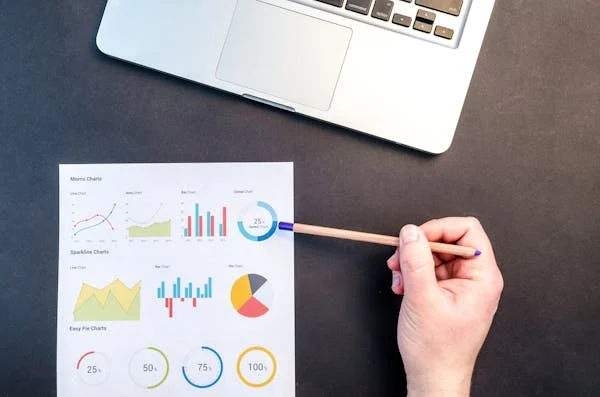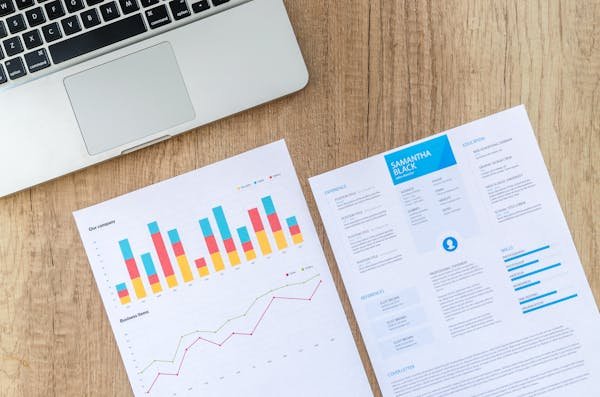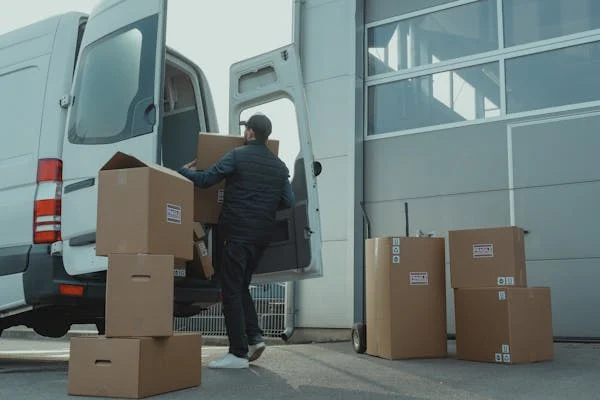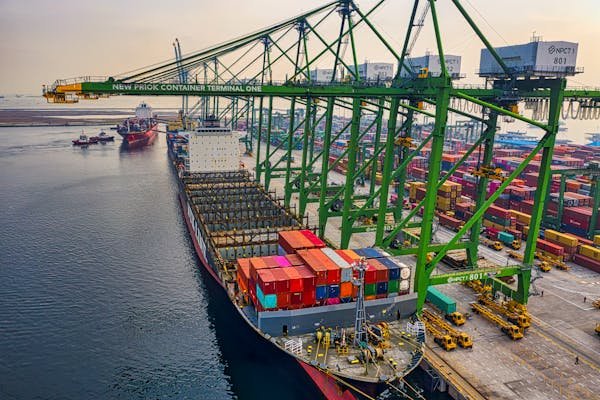Third-party logistics (3PL) services have become the backbone of modern supply chains. With businesses increasingly focusing on efficiency, cost-saving, and customer satisfaction, outsourcing logistics has gone from being optional to absolutely essential. This article dives into 30 critical statistics that show just how vital 3PLs are across different industries. But we don’t stop at just stats—we’ll break down each one, explain why it matters, and offer practical advice on what businesses should do about it.
1. The global 3PL market was valued at $1.4 trillion in 2022
Understanding the Scale
The logistics industry isn’t just big—it’s massive. At $1.4 trillion in 2022, the global 3PL market has clearly become a core component of global trade. This number isn’t just impressive—it’s telling. It shows that businesses across the world trust 3PL providers to handle their supply chains.
What’s driving this? The explosion of e-commerce, globalization, complex supply chains, and increasing consumer demands. Managing logistics internally has become too cumbersome, too expensive, and too slow for most companies.
Why It Matters for Your Business
If you’re still handling logistics in-house, this number should make you pause. Businesses that adopt 3PL services early often gain a competitive edge. They scale faster, serve customers better, and often at lower cost.
So, ask yourself: Is logistics really your strength? Or would your business be better served by focusing on product, marketing, and customer experience while someone else handles the heavy lifting?
Actionable Advice
- Evaluate your current logistics costs. Include hidden costs like manpower, delays, and warehousing inefficiencies.
- Benchmark your logistics KPIs (delivery times, return rates, etc.) against industry standards.
- Talk to at least three 3PL providers. See what they can offer—some might surprise you with tech-driven solutions or lower costs.
2. The market is projected to reach $1.75 trillion by 2026, growing at a CAGR of 6.3%
A Market on the Move
A compound annual growth rate (CAGR) of 6.3% means steady and sustained momentum. This growth is not a bubble—it’s structural. As digital commerce continues to rise, so does the need for smarter logistics.
This stat tells you that 3PL is not just a trend; it’s a long-term shift. It means more companies are trusting 3PLs with core business functions, not just storage or transportation.
What This Means for Stakeholders
If you’re a business owner, this growth means two things. One, your competitors are likely moving toward 3PLs. Two, the market is evolving fast. So standing still means falling behind.
And if you’re a startup? Good news. You don’t need to invest heavily in warehouses or fleets. Instead, partner with a 3PL provider and scale smarter.
Actionable Advice
- Stay updated on innovations in the logistics space—especially in tech like AI routing, real-time tracking, and automation.
- Revisit your 3-year business plan. Consider how external logistics can help you grow faster or enter new markets.
- Avoid long-term logistics contracts unless the provider offers flexibility. You need to stay agile.
3. North America accounted for over 35% of the global 3PL market in 2023
The North American Leadership
When over a third of the entire global market comes from one region, it’s a strong signal. North America—especially the US—has been a pioneer in logistics infrastructure, from highways to tech-driven warehousing.
This is both an opportunity and a benchmark. Companies in North America have access to world-class 3PL providers and advanced logistics technologies. But that also means competition is fierce.
What You Can Learn from This
Whether you’re in North America or not, look to this region for best practices. Providers here are pushing the limits with automation, predictive analytics, and seamless integration with retail and e-commerce platforms.
If you’re in this region, use it to your advantage. You’ve got the best players at your doorstep—use them.
Actionable Advice
- Attend North American logistics expos or webinars to see what’s trending.
- If you’re expanding globally, consider anchoring operations in North America to leverage this ecosystem.
- Test multiple 3PL providers in North America to compare capabilities, customer support, and technology platforms.
4. E-commerce 3PL usage grew by 20% year-over-year since 2020
The E-Commerce Explosion
The pandemic accelerated e-commerce adoption, and logistics had to catch up fast. As online orders surged, so did the demand for fast, reliable delivery. This 20% year-over-year growth tells a clear story: e-commerce can’t function efficiently without 3PLs anymore.
From same-day delivery to handling returns, 3PLs are now embedded in the online shopping experience.
The New Normal
For e-commerce brands, logistics isn’t just backend—it’s part of the brand promise. Late or damaged deliveries hurt your reputation. Fast, accurate service builds loyalty.
That’s why top e-commerce players integrate with 3PLs who can offer full-service fulfillment: pick-pack-ship, inventory management, and returns.
Actionable Advice
- Choose a 3PL that integrates with your e-commerce platform (Shopify, WooCommerce, etc.).
- Set logistics SLAs (Service Level Agreements) with your 3PL. Don’t just hope things will run smoothly—contractually define it.
- Leverage your 3PL for real-time customer updates. If customers know where their order is, they’re less likely to complain.
5. Over 90% of Fortune 500 companies use at least one 3PL provider
The Power of Delegation
Fortune 500 companies aren’t just big—they’re smart. They’ve figured out that logistics is too complex to manage alone. That’s why 90% of them rely on 3PLs. It’s not just about moving goods; it’s about efficiency, scale, and focus.
They use 3PLs to enter new markets, manage seasonal spikes, and reduce fixed costs.
Why You Should Take Note
You don’t have to be a Fortune 500 company to learn from them. If they’re outsourcing logistics, it probably means it works. They have the data, the resources, and the experts. So their decisions are worth paying attention to.
If you’re managing your own logistics, take a hard look—are you doing it because it’s working, or just because it’s what you’ve always done?
Actionable Advice
- Study how major companies use 3PLs. Many share logistics strategies in annual reports or press releases.
- Don’t try to reinvent the wheel. Partner with the same 3PLs these giants trust—you might get similar service, scaled for your size.
- As your company grows, look for 3PLs that can scale with you, rather than switching providers later.
6. Retail and consumer goods account for over 23% of global 3PL revenues
The Retail Engine
Retail and consumer goods have always been logistics-heavy sectors. From high product turnover to managing peak seasons, they demand speed, flexibility, and flawless inventory control. That’s why over 23% of global 3PL revenues come from this segment.
What does that tell us? Retailers are heavily dependent on logistics partners to keep their shelves—and online stores—stocked and running.
Complexity Behind the Scenes
In retail, things can change fast. A single product going viral on social media can cause a stockout. Seasonal sales can create 10x demand overnight. Managing all this in-house would be chaotic and expensive. That’s where 3PLs step in with their warehousing networks, real-time tracking, and demand forecasting systems.
Whether you’re running a brick-and-mortar store or an online boutique, partnering with a good 3PL can mean the difference between success and stockouts.
Actionable Advice
- Prioritize 3PLs with strong retail experience—ask for client case studies or references from retail companies.
- Look for providers that offer scalable storage and labor—so you’re covered for Black Friday, back-to-school, or sudden demand spikes.
- Integrate your sales platform with your 3PL’s WMS (Warehouse Management System) for real-time stock syncing.
7. 95% of e-commerce businesses rely on 3PLs for fulfillment services
Trusting the Experts
Fulfillment isn’t just packing boxes—it’s inventory forecasting, managing returns, avoiding delays, and delivering smiles to customers. That’s why 95% of e-commerce businesses—basically everyone—use 3PLs.
When you’re focused on product development, marketing, and customer service, you don’t want to worry about finding packaging materials or hiring seasonal warehouse workers.
Why Fulfillment is a Deal-Breaker
One bad delivery experience can cost you a loyal customer. That’s why e-commerce brands take fulfillment seriously. A reliable 3PL ensures consistency and frees you up to scale without burning out your team.
From solo entrepreneurs to multi-brand marketplaces, outsourcing fulfillment has become a standard operating strategy.

Actionable Advice
- Choose a 3PL with fulfillment centers near your customer base to reduce delivery time.
- Ask potential 3PL partners about their return handling processes—returns are a big part of e-commerce and need to be frictionless.
- Monitor fulfillment error rates regularly. If your 3PL is mispacking orders, you need to know early.
8. Asia-Pacific is expected to witness the fastest 3PL growth at a CAGR of 8.2% from 2023 to 2028
The APAC Acceleration
Asia-Pacific isn’t just a growing market—it’s a booming logistics powerhouse. With economies like China, India, and Southeast Asia leading a digital and manufacturing surge, 3PL services are seeing explosive growth here.
An 8.2% CAGR over five years is serious. It means businesses in the region are scaling, exporting, and optimizing fast—and logistics is at the heart of it all.
What This Means Globally
If you’re sourcing from, selling to, or expanding into Asia-Pacific, having a logistics partner with local expertise is critical. It’s a region of opportunity, but also complexity—regulatory differences, fragmented infrastructure, and huge geographical spread.
3PLs that understand the local terrain help you avoid pitfalls and move fast.
Actionable Advice
- If you’re sourcing from APAC, partner with 3PLs who have offices or partners on the ground.
- If you’re selling in APAC, make sure your 3PL can handle customs, language, and local payment delivery preferences.
- Use regional warehouses for faster deliveries—cross-border shipping is slow and often expensive.
9. 57% of shippers report cost reduction as the top benefit of 3PL services
Saving Money Where It Counts
The logistics budget often eats up a big chunk of operational expenses. So it’s no surprise that 57% of shippers say cutting costs is the biggest benefit of working with 3PLs.
When you outsource logistics, you reduce or even eliminate warehousing costs, fleet management expenses, and full-time logistics staff. You also gain access to bulk shipping discounts that your business likely couldn’t negotiate alone.
But It’s Not Just About Cutting Corners
Cost reduction doesn’t mean cheap—it means efficient. The best 3PLs optimize routes, consolidate shipments, reduce returns, and help prevent overstocking or stockouts. It’s about smarter, not smaller.
Actionable Advice
- Compare your current logistics costs (in-house) with quotes from multiple 3PLs. Look beyond base prices—factor in delivery success rates, delays, and scalability.
- Audit how many resources your team spends on logistics. That time could be reinvested in core growth.
- Negotiate performance-based pricing with your 3PL—e.g., lower fees for on-time deliveries above 95%.
10. The automotive sector represents approximately 14% of global 3PL demand
High Stakes and High Volumes
The automotive industry runs on precision. From just-in-time parts delivery to global sourcing of components, it requires logistics that are fast, accurate, and resilient. That’s why nearly 14% of global 3PL demand comes from this sector.
Automotive supply chains involve thousands of parts, multiple countries, and tight production schedules. Any delay can shut down a production line—costing millions.
3PLs specializing in automotive logistics provide not just transportation, but also sequencing, quality inspection, and line-side delivery.
Logistics That Keep Wheels Turning
3PLs in this space must work like clockwork. They often operate in real-time with the manufacturer’s ERP systems, delivering parts hours before they’re needed, not weeks.
For suppliers or aftermarket players, this level of sophistication is essential to stay competitive.
Actionable Advice
- If you’re in the auto space, work with 3PLs that have proven automotive clients—ask for specific use cases and KPIs.
- Implement shared logistics dashboards to improve transparency and reduce communication lags.
- Look into value-added logistics services like kitting or pre-assembly that your 3PL can offer.
11. In 2024, 57% of US companies outsourced more logistics than the year prior
A Year of Delegation
In 2024, over half of US companies handed off more of their logistics operations than they did the year before. That tells you one thing: logistics is no longer just a department—it’s a strategic function that’s best managed by experts.
What’s causing this shift? It’s partly due to the unpredictability of global supply chains. And partly due to rising expectations—next-day delivery isn’t a perk anymore, it’s standard.
A Mindset Shift
More companies are realizing that doing everything in-house slows them down. By outsourcing logistics, they get faster, leaner, and more adaptable. Whether it’s warehousing, last-mile delivery, or inventory management, more businesses are choosing to let go of control in exchange for performance.
And here’s the thing—it’s not just large corporations making the move. Startups and midsize businesses are also joining the trend.
Actionable Advice
- Do a logistics audit: What areas are still in-house that could be outsourced to a specialist?
- Review customer service complaints—how many are logistics-related? That’s where to start.
- If you’ve already outsourced, ask: what more can my 3PL do? Many offer services like returns management, packaging, or even customer support.
12. 71% of manufacturers plan to increase their use of 3PL services by 2026
Manufacturing Gets Smarter
Manufacturers today are under pressure to produce faster, cheaper, and with greater flexibility. That’s why 71% of them are planning to boost their reliance on 3PLs by 2026. They need partners who can handle the flow of raw materials in and finished goods out—without friction.
This trend signals a bigger shift: manufacturers want to focus on what they do best—building—and let logistics experts handle the rest.
From Production Line to Delivery Route
The modern factory is no longer a silo. It’s part of a global network that depends on real-time data, flexible transportation, and coordinated warehousing. 3PLs are stepping in to manage everything from inbound shipments to end-customer delivery.
It’s all about speed, synchronization, and smarter decision-making.
Actionable Advice
- Choose a 3PL with industrial experience—they should understand manufacturing schedules, production bottlenecks, and supply lead times.
- Ask if your logistics provider can integrate with your ERP or MRP system to automate order planning and tracking.
- Consider co-locating inventory near your production hubs for faster assembly and dispatch.
13. 40% of 3PL contracts now include value-added services beyond transportation
More Than Trucks and Warehouses
Today’s 3PLs aren’t just moving boxes—they’re offering services that enhance the entire supply chain. 40% of contracts now include things like packaging, kitting, labeling, customization, inspection, and even light assembly.
This means businesses are looking for 3PLs who go beyond logistics—they want partners who can directly support their operations.
Turning 3PLs Into Growth Engines
When your logistics partner can also package, kit, and prep orders, you reduce handling time, lower labor costs, and boost delivery accuracy. This is especially valuable for businesses that deal with high-SKU counts or customized orders.
It’s not just about saving money. It’s about getting closer to the customer and delivering a better experience.

Actionable Advice
- Revisit your 3PL contract—what extras could they provide that you’re currently handling in-house?
- If you’re dealing with SKUs that need bundling or customization, look for 3PLs offering kitting or light manufacturing.
- Treat your 3PL like a strategic partner—bring them into product launches or seasonal campaigns early.
14. Reverse logistics makes up 15–20% of 3PL business in e-commerce
Returns Are the New Normal
In e-commerce, returns aren’t the exception—they’re part of the customer experience. That’s why reverse logistics now accounts for up to 20% of 3PL activity in the online retail space.
It’s not just about taking items back. It’s about inspecting, restocking, refurbishing, or even disposing of them efficiently.
The Cost of Ignoring Returns
Returns can be expensive. Every returned item costs money to process, reship, and restock. And if not handled well, it leads to poor reviews and lost trust. That’s why savvy e-commerce businesses are treating reverse logistics as a key pillar, not an afterthought.
The right 3PL can turn this potential loss into a streamlined, cost-efficient system.
Actionable Advice
- Choose a 3PL with a clearly defined reverse logistics process—ask about inspection, restocking, and disposal policies.
- Use return data to find patterns: Are certain items returned more often? Is packaging a factor? Act on the insights.
- Offer your customers clear, easy-to-use return options. Friction here causes churn.
15. Cold chain 3PL services are growing at a CAGR of 13.4%, driven by food and pharma
The Rise of Temperature-Sensitive Logistics
Cold chain logistics is one of the fastest-growing segments in 3PL, with a CAGR of 13.4%. This growth is powered by two key sectors: food and pharmaceuticals. These industries depend on tightly controlled temperature ranges to maintain product safety and quality.
And it’s not just about refrigerated trucks. It includes temperature-controlled warehousing, real-time monitoring, and compliance with strict regulations.
The Stakes Are High
A single temperature slip can spoil an entire batch of vaccines or perishable food. That’s why businesses in this space can’t afford subpar logistics. The right 3PL isn’t just a vendor—they’re a risk mitigation partner.
And as consumer demand for fresh, frozen, or biologically sensitive products rises, so does the need for specialized cold chain expertise.
Actionable Advice
- Work with certified cold chain 3PL providers—look for GDP (Good Distribution Practice) or HACCP compliance.
- Insist on temperature logs and real-time monitoring—don’t take their word for it.
- Plan for contingencies—what happens if a truck breaks down or a cooler fails? Your 3PL should have an answer.
16. Healthcare logistics account for 12% of 3PL market share globally
Precision Meets Responsibility
Healthcare logistics isn’t just about speed—it’s about precision, compliance, and responsibility. With 12% of the global 3PL market now serving healthcare, this sector is clearly leaning on specialized logistics to ensure medicines, devices, and equipment get where they need to go, safely and on time.
From cold storage for vaccines to secure handling of high-value medical devices, the logistics behind healthcare is anything but basic.
Trust Is Non-Negotiable
In healthcare, mistakes aren’t just costly—they can be life-threatening. So the bar for 3PLs is higher. Providers must follow strict protocols, offer end-to-end traceability, and maintain full compliance with regulations like FDA, HIPAA, or EU MDR.
If you’re operating in the medical or wellness space, you can’t afford to work with generalist 3PLs.
Actionable Advice
- Choose a 3PL with proven healthcare expertise—request audit trails, certifications, and customer case studies.
- Ensure they can handle product recalls smoothly. That’s a must in healthcare logistics.
- Integrate compliance into your logistics SLAs—this reduces risk and sets clear expectations.
17. 60% of 3PL users report improved customer service performance
Logistics as a Brand Experience
When you think of customer service, you might picture support reps or live chat. But in reality, logistics plays a huge role in customer satisfaction. 60% of businesses that use 3PLs say it has improved their customer service.
That’s because customers expect fast, accurate, and visible deliveries. When logistics goes wrong, they don’t call FedEx—they call you.
Delivery Is the Final Touchpoint
In many industries, your product’s delivery is the final—and most memorable—step in the customer journey. A damaged box, a late parcel, or a confusing return can taint the entire experience. But a fast, seamless delivery? That builds trust and repeat business.
3PLs have the tools and networks to ensure that experience is consistent and professional.
Actionable Advice
- Sync your customer support and logistics teams—if an order’s delayed, your support team should know before the customer calls.
- Use delivery notifications and live tracking to reduce “where’s my order” calls.
- Ask your 3PL for performance reports—on-time delivery, damage rates, and NPS impact.
18. 92% of 3PL providers offer real-time tracking and visibility solutions
Seeing Is Believing
In today’s on-demand world, real-time tracking isn’t a bonus—it’s a baseline. That’s why 92% of 3PL providers now offer visibility tools that let you (and your customers) know exactly where your shipments are, at any given time.
This visibility improves planning, reduces uncertainty, and gives you control over exceptions before they become full-blown problems.
Transparency Builds Trust
Whether you’re shipping to customers or restocking your inventory, having eyes on every shipment helps you make better decisions. For example, if a supplier shipment is running late, you can adjust production or alert retail partners in advance.
And when customers can track their orders live, you’ll notice fewer support tickets and greater satisfaction.

Actionable Advice
- Ensure your 3PL platform integrates with your existing systems (e.g., ERP, Shopify, Salesforce).
- Use tracking data for proactive customer communication—send alerts before customers ask.
- Create exception workflows—what happens when a shipment is late, stuck, or rerouted? Document it and automate it.
19. Technology investments in 3PLs are growing at over 10% annually
Smarter Logistics, Faster Business
The logistics world is going digital. With tech investments growing over 10% per year, 3PLs are evolving fast—implementing AI-driven route optimization, warehouse robotics, real-time inventory forecasting, and more.
This matters to your business because a tech-savvy 3PL doesn’t just move faster—they think faster. They help you adapt in real time, forecast better, and serve customers more intelligently.
Tech Is a Differentiator
In competitive markets, logistics speed and reliability can make or break your brand. The right 3PL can give you tech features that would cost you millions to build in-house.
That includes live dashboards, order syncing, predictive analytics, and even demand planning.
Actionable Advice
- Ask potential 3PLs what technology stack they use. The best ones will proudly show it off.
- Look for automation in their processes—manual data entry causes delays and errors.
- Use their tools to reduce your own workload—most offer dashboards, alerts, and analytics to streamline your ops.
20. Last-mile delivery accounts for 41% of total 3PL costs in urban areas
The Final Mile Challenge
The most expensive—and complex—part of delivery isn’t international shipping or cross-country trucking. It’s the last mile: getting the package from a local hub to the customer’s doorstep. In urban areas, this eats up a staggering 41% of total logistics costs.
Why so high? Congested roads, unpredictable traffic, multiple delivery attempts, and customer no-shows. It’s a minefield of inefficiencies.
Solving for the Last Mile
3PLs are now investing in micro-fulfillment centers, crowdsourced delivery fleets, and even electric bikes to solve this challenge. And the results are promising—faster deliveries, lower costs, and happier customers.
For your business, optimizing this one segment can significantly boost margins and customer satisfaction.
Actionable Advice
- Choose 3PLs with local hubs close to your customer base—less distance means lower cost.
- Consider offering pick-up points or locker delivery for high-density cities.
- Use delivery time windows or appointment scheduling to increase first-attempt success rates.
21. Cross-border e-commerce 3PLs are growing at a CAGR of 16.2%
Going Global, Without the Headaches
Selling globally is exciting—but shipping globally? That’s where things get tricky. Customs, taxes, varying regulations, and language barriers can quickly become overwhelming. That’s why cross-border 3PLs are growing fast, with a CAGR of 16.2%.
They handle the hard stuff so you can reach new markets without needing to set up warehouses or hire local teams.
No Borders, Just Opportunity
Whether you’re a small brand or a growing enterprise, international customers expect the same level of service as domestic ones. That means fast, transparent shipping—even across oceans. A good cross-border 3PL knows how to make this seamless.
They offer localized delivery options, manage customs paperwork, and often pre-calculate duties and taxes for a smoother buyer experience.

Actionable Advice
- Before expanding globally, talk to 3PLs with cross-border expertise—don’t go in blind.
- Make your shipping policy clear on your website—customers should know delivery times and costs upfront.
- Choose a 3PL that can handle landed cost calculations (duties + taxes) to avoid customer frustration at delivery.
22. Omnichannel retailing increased 3PL usage by 28% in the past two years
When Shopping Happens Everywhere
Today’s consumers buy online, in-store, on social media, and sometimes all in the same day. Omnichannel retailing—blending multiple sales channels—has become the new norm. And this shift has increased 3PL usage by 28% in just two years.
That’s because omnichannel fulfillment is complex. You need inventory syncing, fast replenishment, and flexible delivery from every direction.
3PLs as Omnichannel Orchestrators
The right 3PL doesn’t just fulfill orders—they support a full retail ecosystem. They ensure your physical and digital channels are synced, so inventory updates in real-time, returns are seamless, and customer expectations are met wherever they shop.
Without a 3PL, omnichannel fulfillment can turn into a logistical nightmare.
Actionable Advice
- Choose a 3PL with omnichannel integrations—Shopify, Amazon, POS systems, ERPs, and marketplaces.
- Make sure your 3PL supports BOPIS (Buy Online, Pick Up In Store), ship-from-store, and return-to-store.
- Monitor fulfillment times across channels and optimize based on performance—not all channels behave the same.
23. Energy and chemical sectors represent 8% of global 3PL usage
High-Stakes, High-Compliance Logistics
The energy and chemical industries might not be as visible as retail or e-commerce, but they rely heavily on logistics. In fact, they make up 8% of global 3PL demand. The reason? Hazardous materials, regulatory complexity, and safety requirements.
Moving chemicals, fuel, or industrial materials is not your average delivery job. It demands expertise, certifications, and meticulous planning.
Not Just Delivery—It’s Risk Management
3PLs in this space must adhere to international safety protocols, track every shipment precisely, and prepare for emergency situations. These industries are choosing partners with specialized fleets, secure warehousing, and compliance support.
Even a small mistake here can lead to huge fines—or environmental disaster.
Actionable Advice
- Partner only with 3PLs certified in hazardous materials transport—ask for training records and safety documentation.
- Establish detailed SOPs (Standard Operating Procedures) for every step, from labeling to offloading.
- Run safety audits regularly, even if your 3PL claims compliance. You’re still responsible in the eyes of regulators.
24. The average 3PL contract length is now 3.4 years
Long-Term Partnerships, Not Quick Fixes
At an average of 3.4 years, most 3PL relationships are not short-term. That’s because businesses are looking for stability, consistency, and long-term value from their logistics partners.
Switching 3PLs is expensive, time-consuming, and disruptive. That’s why companies are doing more due diligence upfront—and choosing providers they can grow with.
It’s About More Than Price
The cheapest 3PL might not be the best fit for the long haul. You want a partner who understands your business, scales with you, and supports your goals. A long contract helps ensure operational continuity and deeper collaboration.
But remember—long doesn’t mean rigid. Flexibility and adaptability are still crucial.
Actionable Advice
- Negotiate SLAs (service level agreements) into your long-term contract—don’t rely on vague promises.
- Include quarterly reviews and exit clauses in your contract. If things go south, you need options.
- Choose 3PLs with a growth mindset—they should want to innovate with you, not just lock you in.
25. 3PL startups received over $5 billion in venture capital funding in 2023
Innovation at Full Speed
Logistics isn’t stuck in the past anymore. In 2023 alone, over $5 billion in VC funding flowed into 3PL startups. These new players are using tech to solve age-old problems—like route inefficiency, poor visibility, or slow fulfillment.
And they’re not just disrupting—they’re partnering with businesses like yours to deliver faster, smarter, and cheaper logistics.
New Players, New Possibilities
Many of these startups focus on niche areas like hyper-local delivery, same-day shipping, returns automation, or AI-powered inventory management. They offer agility and innovation that big providers sometimes can’t match.
So if you’re looking for a logistics edge, the next great 3PL might not be the biggest—but the smartest.
Actionable Advice
- Don’t ignore 3PL startups—they may offer better tech and service than legacy providers.
- Ask how they’re using AI, automation, or predictive data to improve operations.
- Look into partnerships and pilot programs—many startups offer flexible terms for early adopters.
26. 82% of companies said supply chain disruptions increased their 3PL reliance
The Wake-Up Call
If recent years taught businesses anything, it’s this: supply chains can break—fast. Whether it’s a pandemic, war, natural disaster, or container shortage, disruptions have become more frequent and more severe.
That’s why 82% of companies increased their 3PL usage in response. When things get unstable, businesses want flexibility, backup plans, and experts who can pivot fast. That’s what a good 3PL offers.
Agility Beats Chaos
Trying to handle a global disruption with in-house resources is like using duct tape on a sinking ship. The companies that came out ahead didn’t have bigger warehouses—they had smarter partners.
3PLs bring diversified networks, scalable capacity, and real-time data—all of which are critical in a crisis.

Actionable Advice
- Build redundancy into your logistics—multiple warehouses, diversified transport partners, and backup inventory.
- Choose 3PLs with proven crisis response strategies—ask how they managed during COVID or the Suez Canal blockage.
- Monitor global risk factors through your 3PL dashboard—many now offer predictive alerts for weather, strikes, or port congestion.
27. Cloud-based 3PL systems adoption is projected to reach 75% by 2026
Logistics in the Cloud
More than ever, logistics is moving to the cloud. By 2026, it’s expected that 75% of 3PLs will run fully cloud-based systems. Why? Because cloud tech offers speed, security, scalability—and, most importantly, real-time coordination across multiple players.
If your logistics partner isn’t using cloud-based platforms, you’re operating in the past.
Real-Time Sync, Real-Time Decisions
Cloud logistics platforms allow seamless data sharing across your business—sales, support, procurement, and fulfillment all stay in sync. You avoid the lag, errors, and silos that slow down traditional systems.
This connectivity isn’t just nice to have—it’s essential for agility, customer satisfaction, and cost control.
Actionable Advice
- Ask your 3PL what platforms they use—is it cloud-native or legacy tech with patches?
- Use API integrations to connect your own systems with your 3PL’s cloud platform for better forecasting and smoother workflows.
- Prioritize partners who offer data access, not just reports—you want full visibility, not just summaries.
28. 69% of 3PLs now offer sustainability reporting to clients
Green Is the New Standard
With 69% of 3PLs now offering sustainability reports, it’s clear that environmental performance is no longer optional. More brands—and customers—expect logistics partners to track emissions, reduce waste, and prove their eco-friendly credentials.
And smart businesses aren’t just doing this to feel good—they’re doing it because buyers care, regulators are watching, and investors are asking.
Supply Chains Go Sustainable
From carbon-neutral shipping to electric delivery fleets and smarter packaging, 3PLs are becoming a core part of many companies’ ESG strategies. If you’re serious about sustainability, you need a 3PL who can help you prove and improve your impact.
That includes data transparency, performance benchmarking, and continuous optimization.
Actionable Advice
- Choose a 3PL with a published sustainability roadmap—ask about emissions tracking, fuel choices, and packaging materials.
- Use sustainability data in your own annual reports and marketing—customers want to know.
- Look for certification programs—like SmartWay or ISO 14001—to ensure your 3PL isn’t greenwashing.
29. Third-party warehousing services grew by 18% in North America in 2023
Storage as a Service
In 2023, demand for third-party warehousing in North America jumped by 18%. Why? Because more businesses want flexible, scalable storage without the headache of managing facilities themselves.
Third-party warehouses aren’t just big empty spaces anymore—they’re smart, automated, and connected to fulfillment networks.
Flexibility for Fast-Moving Brands
From DTC brands scaling fast to wholesalers managing seasonal peaks, the demand for outsourced warehousing shows no signs of slowing. And when combined with fulfillment services, it creates a one-stop logistics solution.
This trend is about agility, not just space.
Actionable Advice
- Choose 3PLs with multi-client warehousing—this gives you better cost-sharing and flexibility.
- Ask how their warehousing integrates with fulfillment and transportation—avoid disjointed logistics.
- Don’t overcommit—choose flexible warehousing agreements that grow (or shrink) with your business.
30. Digital freight matching platforms are expected to make up 25% of 3PL transactions by 2027
The Uberization of Freight
The future of logistics is digital, and nowhere is that more clear than with freight matching platforms. These systems, like Uber for freight, match shippers with available trucks in real-time. By 2027, they’ll account for 25% of all 3PL transactions.
That means faster shipments, fewer empty trucks, and better rates.
Smarter Shipping Decisions
These platforms use AI to optimize routing, pricing, and carrier selection. They also give businesses more control over booking, tracking, and rescheduling.
For shippers, this means fewer phone calls and more transparency. For carriers, it means better utilization and faster turnaround.

Actionable Advice
- Use 3PLs who plug into digital freight marketplaces—this increases your shipping options and responsiveness.
- Monitor market rates and trends directly—many platforms provide real-time pricing data.
- Be ready to shift from static carrier contracts to dynamic pricing models where appropriate.
Conclusion:
The third-party logistics market isn’t just growing—it’s evolving rapidly. With smarter technology, rising demand for speed and sustainability, and increasing complexity in global supply chains, the role of 3PLs is more important than ever.





















